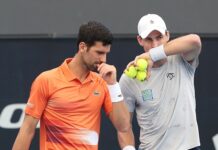Bill Simons and Vinay Venkatesh
New York
What an achievement!
For the first time since 2003, America got four players into a Grand Slam semifinal – Taylor Fritz, Frances Tiafoe, Jessica Pegula and Emma Navarro. The four have some fascinating threads of commonality. Where to begin?
For starters, decades ago, Emma Navarro’s great grandfather came from Italy to New York’s Ellis Island and set the foundation for a vastly successful American clan that gave us a much celebrated football coach and a financial whiz.
As an infant, Pegula’s mother was abandoned on the steps of a police station in Seoul, Korea. Incredibly, she, too eventually made it to New York and saw her family rise to the top of the sporting world. Now, her daughter who scored a stunning 1-6, 6-4, 6-2 comeback win over Karolina Muchova is into her first Slam final.
Famously, Tiafoe’s parents came to America after they fled Sierra Leone’s brutal civil war that displaced 2.5 million people. As fate would have it, his dad became a maintenance man at Maryland’s Junior Tennis Champions Center, where he’d sleep in a storage room with his son.
As for Taylor Fritz, his family were merchants in St. Louis in the 19th century.
Tennis is known as a wealthy country club sport. The costs are brutal. Top-notch coaching, rackets and gear, long distance travel and a mental health advisor or two – it can easily cost you $100,000 a year just to take a shot at making it.
So it’s counterintuitive that, far from tennis’ leafy havens, so many American-based stars emerged from humble beginnings. Althea Gibson knew the streets of Harlem well. Arthur Ashe’s dad was a park worker. Billie Jean King’s father was a fireman. Andre Agassi’s dad lived in a one-room apartment in Tehran, Iran, with 12 others, before heading out with an empty wallet to Chicago, where he became an elevator operator.
Maria Sharapova’s dad had $900 when he left Russia for Florida, where he’d take his daughter to tennis lessons on his bicycle.
Tommy Paul’s parents had little wealth. And, most notably of all, a couple of girls named Venus and Serena came out of gritty Compton, and “woke ‘em up at the country club.” The sport has never been the same.
At the US Open, three of America’s four semifinalists came from vast wealth.
Navarro, who Thursday was overpowered by Aryna Sabalenka 6-3, 7-6(2), has won one tennis tournament. Her dad, Ben, owns three – Cincinnati, Charleston and Monterrey, Mexico. He has a net worth of $1.5 billion and has built a stunning banking and credit card empire based on providing credit cards and loans to high-risk borrowers.
Pegula’s parents own the Buffalo Bills and the NHL’s Sabres and have a hefty net worth of $7.7 billion. Fritz’s family owned the lucrative May department store chain that was vastly successful in Southern California.
But who’s kidding who? Wealth alone hardly makes an elite athlete. Let’s face it, there are thousands of tennis wannabes who’ve ended up hanging out at country club bars mumbling, “I coulda been a contender. I coulda been somebody.”
For sure, wealth can buy great tennis instruction and pay for journeys to distant tourneys. Plus it can buy time. If you have money, you don’t have to be an overnight sensation. But Pegula, Navarro and Fritz were not only wealthy, they were vastly talented and incredibly hard workers who time and again called on their steely resilience.
Pegula worked mightily and her rise has taken years. She’s now reached her first semi at age 30. Jessica has long had to navigate the circuit knowing that she was seen as “that billionaire’s kid.” Not surprisingly, the quick-witted Pegula bristled the other day: “People think I have a butler, that I get chauffeured around, I have a limo, that I fly private everywhere. I’m definitely not like that. People can think what they want…It’s a little annoying, but honestly, I just think it’s kind of funny, because I don’t really even know anyone that lives like that.”
Navarro has had great coaching since she was 14. She recalled, “I had access to courts from a young age…[my family’s] wealth did play a role and I’m super grateful…[But] I’ve put a ton of hours in and started training in the gym when I was 8, 9 years old.”
Emma’s coach, Peter Ayers, said that a key to her success was her willingness to hit a billion balls. Yes, the University of Virginia is an elite college – tuition $55,914. But when Emma was on their team she was always the first to arrive to practice and the last to leave.

What is undeniable is that all four of America’s semifinalists come from incredibly supportive sports environments.
Fritz is the product of one of California’s greatest tennis clans. What other guy can say, “Hey, I was No. 5 in the world and my mom [Kathy May] was No. 10.”
Sure, Taylor grew up in Rancho Santa Fe, where polo is a thing. But with the help of his dad, Guy Fritz, and his teaching pro Uncle Harry, he’s bravely progressed step by step, from the juniors to bumpy clay courts in the backwaters of Europe, methodically rising in the unforgiving, Darwinian ranks of tennis. America’s top male player has paid some considerable dues and now, like Pegula and Navarro, has reached his first Slam semi.
Navarro comes from a sports-crazy family. Her grandfather was an innovative football coach at Williams, Princeton and Columbia. Her dad, who once was close to buying the NFL’s Carolina Panthers, owns a tennis club in Mount Pleasant, South Carolina.
And if ever a boy found himself in a dynamic tennis environment, it would be Frances Tiafoe. The son of the janitor at a tennis academy, the wide-eyed kid always sought to find an open court to hit balls at. Coaches quickly came to his aid, billionaire Bill Ackman backed his career and he emerged as the leading light of one of America’s great tennis centers – from Sierra Leone, with love.
Pete Sampras once said, “I’m just a tennis player, nothing more, nothing less.” And you could say that applies to America’s four stars who’ve made it to the Open semis. But their intriguing, labor-intensive and very American backstories fascinate.




















